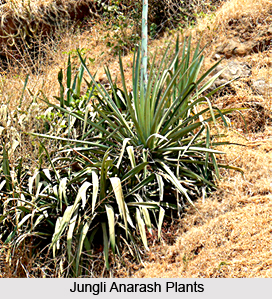 Jungli Anarash was introduced in India in the early 18th century. However this medicinal plant has its origin in the tropical and subtropical America and was used as ornamental plants in many tropical countries between the 16th and 18th centuries. Since then these plants become popular throughout the country, usually on the degraded sites near villages and along roads.
Jungli Anarash was introduced in India in the early 18th century. However this medicinal plant has its origin in the tropical and subtropical America and was used as ornamental plants in many tropical countries between the 16th and 18th centuries. Since then these plants become popular throughout the country, usually on the degraded sites near villages and along roads.
Jungli Anarash or Agavaceae is an erect and stem less plant whose leaves are stout with longitudinal white or yellow streaks or bands, sharply constricted into a neck just above a swollen base. The flowers of this plant are white in colour and their stalks are stout, very tall and woody. Their fruits or capsules are generally oblong and beaked in appearance.
In India these plants are considered as medicinal plants. Different parts of the plant are used for various medicinal purposes. The juice of the leaves is used as a laxative and emmenagogue, and for treating scurvy. Among the tribal inhabitants of Surguja district in eastern Madhya Pradesh, the juice is used as an eardrop for the treatment of earache. The roots of these plants are considered as diuretic, diaphoretic and anti-syphilitic. The core of the plant is used as a febrifuge in treating malaria and other fevers. These are also used as an antiseptic. The plant is used for treating ascites, venereal sores, syphilis and dysentery. The leaves yield a strong, durable fibre used for making ropes, mats, sacking and brushes.
The botanical name of Jungli Anarash plants are Agave cantula Roxb and Agave americana auct. non L. The common name of this plant varies from place to place. The common name of this plant varies from place to place. Such as in Bengali language it is known as Bilati Anarash, Bilatipat, Jungli Anarash and Koyan, in English it is known as American Aloe and Century Plant, in Gujarati it is famous as Jangli Kunvara, in Hindi it is known as Banskeora, Bara Kanwar, Hathi-Sen-Gar, Kantala And Rakas-Pattah; in Punjabi language it is commonly known as Wilaytikaitalu and in Sanskrit it is known as Kalakantala and Kantala.



















